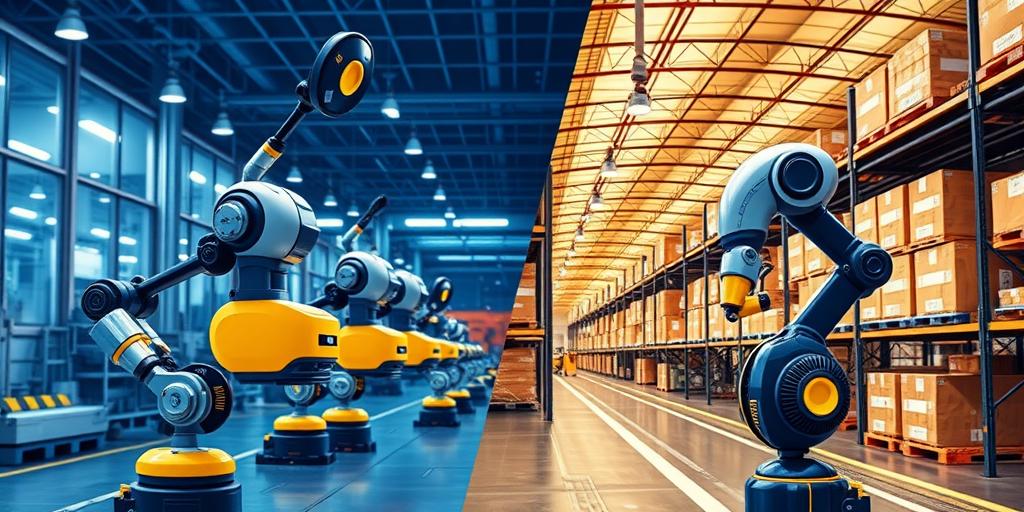The Advancement of Robotics in Manufacturing and Logistics (2025)
In 2025, the integration of robotics within manufacturing and logistics has reached an unprecedented level of sophistication, marked by enhanced efficiency, precision, and adaptability. This article explores the key advancements driving this transformation and their implications for the industry.
Enhanced Automation
Robotics in manufacturing and logistics has evolved from simple automation to complex, integrated systems capable of performing a wide range of tasks. Advanced robots are now equipped with sophisticated sensors, AI-driven decision-making capabilities, and improved dexterity, allowing them to handle intricate processes with minimal human intervention.
Key Advancements:
- AI-Powered Robots: Artificial intelligence and machine learning algorithms enable robots to learn from experience, adapt to changing environments, and optimize their performance in real-time. This leads to improved accuracy, reduced errors, and increased productivity.
- Collaborative Robots (Cobots): Cobots are designed to work alongside humans in shared workspaces, enhancing safety and efficiency. Equipped with force-sensing technology and intuitive interfaces, cobots can assist with repetitive or physically demanding tasks, freeing up human workers to focus on more complex activities.
- Autonomous Mobile Robots (AMRs): AMRs are transforming logistics operations by enabling efficient and flexible movement of goods within warehouses and distribution centers. Unlike traditional automated guided vehicles (AGVs), AMRs can navigate autonomously using advanced sensors and mapping technologies, avoiding obstacles and optimizing routes in dynamic environments.
- Robotic Picking and Packing: Advanced robotic systems are now capable of picking and packing a wide variety of items with speed and precision. These systems utilize 3D vision, machine learning, and dexterous robotic arms to handle delicate or irregularly shaped products, reducing labor costs and improving order fulfillment accuracy.
Applications in Manufacturing
The use of robotics in manufacturing has expanded beyond traditional applications such as welding and assembly to include more complex processes such as additive manufacturing, quality control, and predictive maintenance.
- Additive Manufacturing (3D Printing): Robots are being used to automate various stages of the additive manufacturing process, including material handling, part inspection, and post-processing. This enhances the speed, accuracy, and scalability of 3D printing operations.
- Quality Control: Robots equipped with high-resolution cameras and machine vision algorithms can perform automated quality inspections, identifying defects and anomalies with greater speed and accuracy than human inspectors. This ensures consistent product quality and reduces the risk of defective products reaching customers.
- Predictive Maintenance: By analyzing data from sensors embedded in manufacturing equipment, robots can detect early signs of wear and tear, predict potential failures, and schedule maintenance proactively. This minimizes downtime, reduces maintenance costs, and extends the lifespan of equipment.
Applications in Logistics
In logistics, robotics is revolutionizing warehouse operations, transportation, and last-mile delivery, enabling faster, cheaper, and more reliable delivery services.
- Warehouse Automation: Robots are being used to automate various warehouse tasks, including receiving, storage, picking, packing, and shipping. This improves throughput, reduces errors, and optimizes space utilization.
- Autonomous Vehicles: Self-driving trucks and delivery vans are being tested and deployed for long-haul transportation and last-mile delivery. These vehicles can operate 24/7, reducing labor costs and improving delivery times.
- Drone Delivery: Drones are being used for fast and efficient delivery of small packages in urban areas. Equipped with GPS navigation and obstacle avoidance systems, drones can navigate complex airspace and deliver packages directly to customers’ doorsteps.
Challenges and Opportunities
Despite the numerous benefits, the adoption of robotics in manufacturing and logistics also presents several challenges:
- High Initial Investment: The initial cost of purchasing and deploying robotic systems can be significant, especially for small and medium-sized enterprises (SMEs).
- Integration Complexity: Integrating robots into existing manufacturing and logistics operations can be complex and require specialized expertise.
- Workforce Displacement: The automation of tasks through robotics may lead to job losses for some workers, requiring retraining and upskilling initiatives.
To overcome these challenges, governments, industry associations, and educational institutions are working together to provide funding, training, and support for businesses adopting robotics technologies. This includes:
- Incentive Programs: Governments are offering tax breaks, grants, and subsidies to encourage businesses to invest in robotics and automation.
- Training Programs: Educational institutions and industry associations are developing training programs to equip workers with the skills needed to operate and maintain robotic systems.
- Standards and Guidelines: Industry standards and guidelines are being developed to ensure the safe and responsible use of robotics technologies.
Conclusion
In 2025, the advancement of robotics in manufacturing and logistics has transformed the industry, enabling businesses to improve efficiency, reduce costs, and enhance competitiveness. As robotics technologies continue to evolve, it is crucial for businesses to embrace these advancements and adapt to the changing landscape to remain competitive in the global economy.
